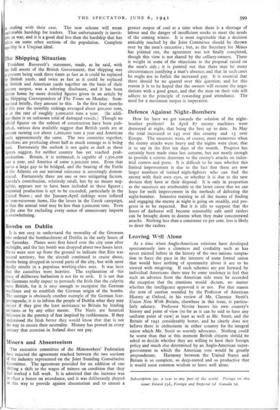The Shipping Situation
President Roosevelt's statement, made, as he said, with the full assent of the British Government, that shipping was at present being sunk three times as fast as it could be replaced by British yards, and twice as fast as it could be replaced by British and American yards together on the basis of their present output, was a sobering disclosure, and it has been driven home by more detailed figures given in an article by the Shipping Correspondent of The Times on Monday. Sum- marised briefly, they amount to this. In the first four months of this year the monthly sinkings averaged about 400,000 tons, or at the rate of roughly 5,000,000 tons a year. (In addi- tion there is an unknown total of damaged vessels.) Though no official figures on the subject of construction have been pub- lished, various data available suggest that British yards are at present turning out about 1,200,000 tons a year and American yards approximately the same. The two countries together, therefore, are producing about half as much tonnage as is being sunk. Fortunately the outlook is not quite as dark as these figures suggest, for neither country has yet reached peak- production. Britain, it is estimated, is capable of 1,500,000 tons a year, and America of some 2,300,000 tons. Even that leaves a large gap to be bridged, and the bearing of the Battle of the Atlantic on our national existence is arrestingly demon- strated. Fortunately there are one or two mitigating factors. Canada's contribution, relatively small, but by no means neg- ligible, appears not to have been included in these figures ; estimated production is apt to be exceeded, particularly in the United States ; and the January-April sinkings were inflated by non-recurrent items, like the losses in the Greek campaign, so that the annual total may be less than 5,000,000 tons. Even so the case for excluding every ounce of unnecessary imports is overwhelming.


























 Previous page
Previous page